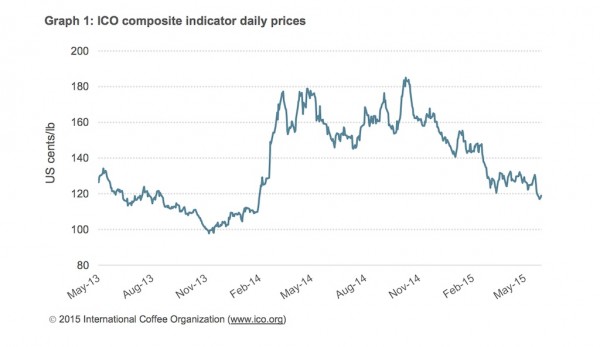The composite price for commodity coffee reached a 17-month low throughout May, as speculation over the 2015/16 crop in Brazil suggests “no immediate supply concerns” in the global market, according to the latest monthly report from the International Coffee Organization. This despite the most recent estimate from Brazilian agriculture agency CONAB that Brazil’s 2015/16 crop will decrease by 2.3 percent to 44.3 million bags.
The ICO’s composite indicator price — which covers three main categories of arabica plus robusta and represents coffees from every major growing region — dropped 4.3 percent on average in May compared to April, to $1.234 per pound. Says the ICO, “The daily price was relatively stable for the first half of the month, but then fell precipitously from just over 130 cents to a low of 116.99, as supply concerns over the Brazilian crop receded.”
Of all the green categories, the most significant drop in May was for robustas — down to an 18-month low of $0.875 cents — a fact the ICO says has led to “anecdotal reports of stocks accumulating in Vietnam, with sellers reluctant to trade at such low domestic prices.” Exports from Vietnam in April, the most recent data period, were down a full 1 million bags from April 2014, which the ICO suggests might mean “significant volumes” of coffee remain, if production in Vietnam has been similar to last year’s levels.
There are also concerns in Indonesia, the world’s fourth largest growing region, where the crop year has begun. The ICO estimates that production in the crop year 2014/15 (April to March) was 9 million bags, a 23 percent decrease from the previous year. The drop is attributed to adverse weather conditions in the middle part of last year. Exports from Indonesia in the last crop year were down by approximately 46 percent, to 5.6 million bags. This can partly be attributed to growing domestic consumption. Says the ICO, “Looking ahead to 2015/16, early indications are that production in Indonesia could recover somewhat, as long as the weather conditions remain favorable.”
Read the full ICO report for May here, including more detail on Brazil and Peru, where the crop year has begun.
Nick Brown
Nick Brown is the editor of Daily Coffee News by Roast Magazine.







Comment